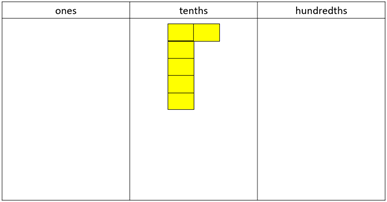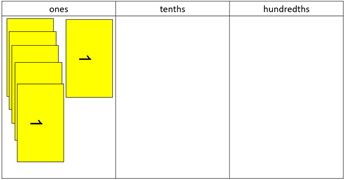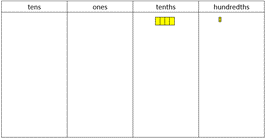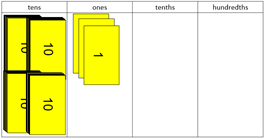Purpose
The purpose of this activity is to support students anticipating the result of multiplying a decimal number by 10 or 100.
Achievement Objectives
NA4-6: Know the relative size and place value structure of positive and negative integers and decimals to three places.
Required Resource Materials
- Decimats (Material Master 7-3)
- Place value mat (photocopied to A3 size)
- Scissors
- Calculators
Activity
- Make the number 0.6 with decimats and a place value mat.
What number have I made?
What does six represent in this number? (six tenths)
What would happen if I made 0.6 ten times greater, if I multiplied it by ten?
Establish that each tenth would become ten times greater and become a one. Ten times 0.6 is therefore 6 ones.

Match the decimat model with a written expression. Although you might initially do this using a horizontal expression like 0.6 x 1, you should progress towards using vertical written algorithms, as shown below. Confirm the result with a calculator.
- Extend the number multiplied by ten to include decimals with two and three places. Make models with decimats and discuss what each place value part becomes as it is multiplied by ten. Tenths become ones, hundredths become tenths, and thousandths become hundredths.
For example, 10 x 0.256 = 2.56. For each number you multiply, create a written expression and use a calculator to confirm the answer.
- Extend the problems to involve decimals multiplied by 100. Begin with a decimal like 0.43 (100 x 0.43 = 43). If each part becomes 100 times larger, then four tenths become four tens, and three hundredths become three ones.


- Use the calculator to establish a symbolic pattern for multiplying a decimals by one, ten, 100 and 1000. Organise the results in a table, like the one shown below for 0.678:

What patterns do you notice in the table?
Students should notice that each multiplication by ten shifts the digits one place to the left from their original position. This pattern allows anticipation of what a decimal becomes when made ten, 100 or 1000 times larger.
Students might notice that the calculator does not show the decimal point when 0.678 is multiplied by 1000.
Why is the decimal point no longer needed?
- Provide practice examples, using physical modelling with decimats only if needed. This could be done in pairs or small groups. As you work, you might introduce relevant te reo Māori kupu, such as the words for numbers and words related to decimals (e.g. tau ā-ira - decimal number). Examples might be:
- 10 x 1.05 =
- 100 x 2.93 =
- 10 x 0.602 =
- 100 x 5.067 =
Next steps
- Apply tens times and 100 times greater to multiplication problems. For example, If 4 x 6 = 24 then 400 x 6 = ? Calculators can be used to confirm predictions.
- Consider what happens when a decimal is divided by ten or 100. For example, if 10 x 2.9 = 29 what is 2.9 ÷ 10 = ? If 100 x 8.4 = 840 what is 8.4 ÷ 100 = ? Calculators can be used to confirm predictions.
Add to plan
Level Four